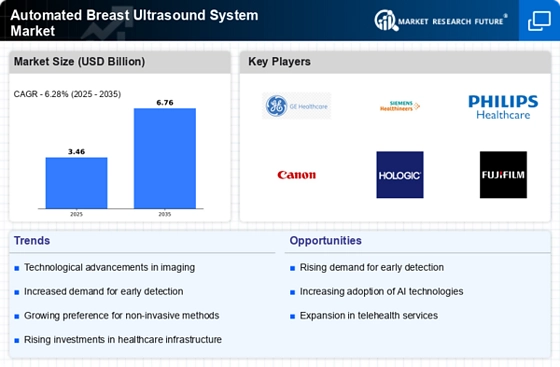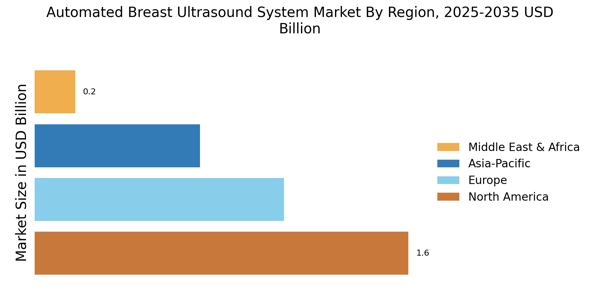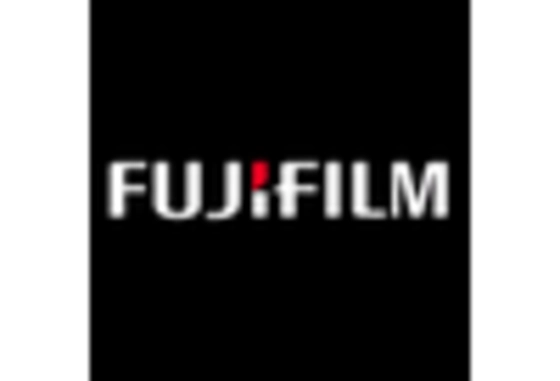Regulatory Support and Guidelines
The Automated Breast Ultrasound System Market is bolstered by supportive regulatory frameworks and guidelines that promote the use of advanced imaging technologies. Regulatory bodies are increasingly recognizing the efficacy of automated breast ultrasound systems in enhancing screening processes. This support is evident in the approval of new devices and the establishment of guidelines that encourage their integration into routine breast cancer screening protocols. As healthcare providers align with these regulations, the market is likely to expand, with an anticipated growth rate of 7% annually through 2025. The emphasis on regulatory compliance ensures that the Automated Breast Ultrasound System Market remains competitive and innovative, ultimately benefiting patient care.
Rising Incidence of Breast Cancer
The increasing incidence of breast cancer worldwide is a primary driver for the Automated Breast Ultrasound System Market. As statistics indicate a rise in breast cancer cases, the demand for effective screening tools becomes more pronounced. Automated breast ultrasound systems offer a non-invasive and efficient method for detecting tumors, particularly in women with dense breast tissue. This growing need for reliable screening solutions is expected to propel market growth, with projections suggesting a market size of USD 1.2 billion by 2025. The Automated Breast Ultrasound System Market is thus positioned to play a crucial role in addressing the challenges posed by rising breast cancer rates, ensuring timely diagnosis and treatment.
Technological Advancements in Imaging
The Automated Breast Ultrasound System Market is experiencing a surge in technological advancements that enhance imaging capabilities. Innovations such as 3D imaging and artificial intelligence integration are improving diagnostic accuracy and efficiency. These advancements allow for better detection of breast abnormalities, which is crucial for early intervention. The market is projected to grow as healthcare providers increasingly adopt these technologies to improve patient outcomes. In 2025, the market is expected to reach a valuation of approximately USD 1.5 billion, driven by the demand for more precise imaging solutions. As technology continues to evolve, the Automated Breast Ultrasound System Market is likely to see further enhancements that could redefine breast cancer screening protocols.
Integration with Other Diagnostic Modalities
The trend towards integrating automated breast ultrasound systems with other diagnostic modalities is shaping the Automated Breast Ultrasound System Market. This integration allows for a more comprehensive approach to breast cancer screening and diagnosis, combining ultrasound with mammography and MRI. Such multimodal strategies enhance diagnostic accuracy and provide healthcare professionals with a more complete picture of breast health. As healthcare facilities seek to improve patient outcomes through advanced diagnostic techniques, the market is likely to see increased adoption of integrated systems. By 2025, the Automated Breast Ultrasound System Market could experience a growth rate of 6%, driven by the demand for holistic diagnostic solutions that cater to diverse patient needs.
Increased Awareness and Screening Initiatives
Rising awareness regarding breast cancer and the importance of early detection is significantly impacting the Automated Breast Ultrasound System Market. Educational campaigns and community outreach programs are encouraging women to undergo regular screenings. This heightened awareness is leading to an increase in the number of women opting for breast ultrasound examinations, particularly in high-risk populations. As a result, the market is witnessing a steady growth trajectory, with an estimated increase in demand for automated systems. By 2025, the market could see a compound annual growth rate (CAGR) of around 8%, reflecting the growing emphasis on proactive health measures. The Automated Breast Ultrasound System Market is thus positioned to benefit from this trend as more healthcare facilities adopt these systems to meet rising patient needs.


















Leave a Comment